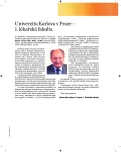Intraindividual variability of uroflowmetry in women
Authors:
M. Gärtner 1; J. Krhut 2,3; M. Juráková 1; S. Bajsová 1; M. Navratilova 1; D. Němec 2; D. Míka 2; J. Tvrdík 4; P. Zvara 3,5
Authors‘ workplace:
Porodnicko-gynekologická klinika OU a FN, Ostrava, přednosta doc. MUDr. V. Unzeitig, CSc.
1; Urologické oddělení FN Ostrava, primář doc. MUDr. J. Krhut, Ph. D.
2; Katedra chirurgických oborů LF OU, Ostrava, přednosta doc. MUDr. P. Zonča, Ph. D., FRCS
3; Katedra informatiky a počítačů PřF OU, Ostrava, vedoucí doc. Ing. C. Klimeš, CSc.
4; Division of Urology, University of Vermont, Burlington, VT, USA, head: Plante MK, MD, FRCS, FACS
5
Published in:
Ceska Gynekol 2014; 79(4): 321-325
Overview
Objective:
The objective of this study was to determine the intraindividual variability of uroflowmetric measurement in women with normal lower urinary tract function.
Design:
Prospective study.
Setting:
Departure of obstetrics and gynecology University Hospital and Medical Faculty Ostrava.
Methods:
35 women without lower urinary tract dysfunction were enrolled into the study. Every subject uderwent 3 uroflowmetric examinations. We processed all numeric results.
Results:
We assessed maximum and average urine flow rate – Qmax, Qave, voided volume – VV, corrected maximum urine flow and corrected average urine flow rate in every of 105 uroflowmetric´s measurements. We did not find any statistically significant difference for evaluation of intraindividual dispersion in studied parameters.
Conclusion:
Intraindividual variability of uroflowmetric´s measurement in healthy female subjects is low. One uroflowmetric´s measurement is adequate for assessment of uroflowmetric´s parameters..
Keywords:
uroflowmetry, intraindividual variability, lower urinary tract
Sources
1. Barapatre, Y., Agarwal, MM., Singh, SK., et al. Uroflowmetry in healthy women: Development and validation of flow-volume and corrected flow-age nomograms. Neurourol Urodyn, 2009, 28, 8, p. 1003–1009.
2. Fantl, JA., Smith, PJ., Schneider, V., et al. Fluid weight uroflowmetry in women. Am J Obstet Gynecol, 1983, 145, 8, p. 1017–1024.
3. Gupta, NP., Kumar, A., Kumar, R. Does position affect uroflowmetry parameters in women? Urol Int, 2008, 80, 1, p. 37–40.
4. Haylen, BT., Ashby, D., Sutherst, JR., et al. Maximum and average urine flow rates in normal male and female populations – the Liverpool nomograms. Br J Urol, 1989, 64, 1, p. 30–38.
5. Haylen, BT., Yang, V., Logan, V. Uroflowmetry: its current clinical utility for women. Int Urogynecol J Pelvic Floor Dysfunct, 2008, 19, 7, p. 899–903.
6. Hintze, J. NCSS 8. NCSS, LLC, 2012, Kaysville, Utah, USA, www.ncss.com.
7. Chou, TP., Gorton, E., Stanton, SL., et al. Can uroflowmetry patterns in women be reliably interpreted? Int Urogynecol J Pelvic Floor Dysfunct, 2000, 11, 3, p. 142–147.
8. Jørgensen, JB., Colstrup, H., Frimodt-Møller, C. Uroflow in women: an overview and suggestions for the future. Int Urogynecol J Pelvic Floor Dysfunct, 1998, 9, 1, p. 33–36.
9. Nitti, VW., Tu, LM., Gitlin, J. Diagnosing bladder outlet obstruction in women. J Urol, 1999, 161, 5, p. 1535–1540.
10. Peter, WP., Drake, WM. Jr. Uroflowmetric observation in gynaecologic patiens. JAMA, 1958, 166, p. 721–724.
11. Schäfer, W., Abrams, P., Liao, L., et al. Good urodynamic practices: uroflowmetry, filing cystometry and pressure – flow studies. Neurourol Urodyn, 2002, 21, p. 261–274.
12. Zmrhal, J., Dorňáková, P., Ščamborová, E., et al. Uro-flowmetrie. Metoda zapomenutá, či potřebná? Prakt Gyn, 14, 1, s. 54.
Labels
Paediatric gynaecology Gynaecology and obstetrics Reproduction medicineArticle was published in
Czech Gynaecology

2014 Issue 4
Most read in this issue
- Amniotic fluid embolism – review
- Prenatal growth curves of the Czech population
- Dysplasia and cervical cancer: current diagnostic possibilities
- Prebioptic methods in the cervical cancer screening
